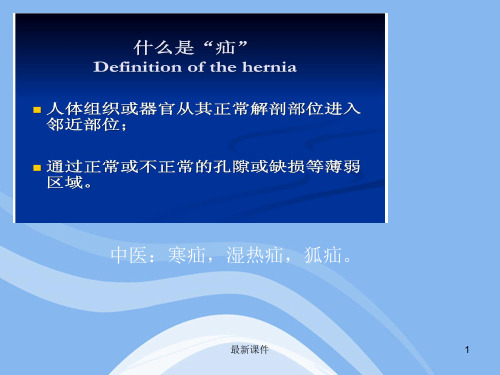脑疝影像学表现PPT课件
合集下载
脑疝的影像学表现ppt课件

大脑镰下疝的影像学表现
01 患侧大脑半球扣带回在镰下孔处向下移位
02 患侧脑室受压变形,中线结构向对侧移位
03
患侧脑实质内可见水肿、出血灶或梗死灶
04
患侧脑沟变浅或消失,脑回增宽
04
脑疝影像学鉴别诊断
脑肿瘤与脑疝的鉴别诊断
脑肿瘤通常表现为颅内占位性病变,可引起颅内压增高,但肿瘤本身不会移动。脑疝则是由于颅内压 不均导致脑组织移位,通常表现为脑组织受压、移位或变形。
脑肿瘤的影像学表现通常较为均质,而脑疝的影像学表现可能因移位的脑组织而出现不均质的密度或信 号。
脑肿瘤的生长速度通常较慢,而脑疝通常是急性发作,影像学表现变化较快。
颅内出血与脑疝的鉴别诊断
颅内出血通常是由于脑血管破裂引起,可表现为颅内占位性病变,但出 血量较大时会引起脑疝。脑疝则是由于颅内压不均导致脑组织移位。
监测治疗效果
手术后,通过影像学检查可以观察到脑组织复位的情况,以及颅内占位性病变去 除的情况,从而评估手术效果。
对脑疝预后的评估价值
预测预后情况
影像学检查可以观察到脑组织受压的程度和范围,以及颅内 占位性病变的性质和大小,这些因素与患者的预后密切相关 ,因此影像学检查对预测患者的预后有一定的价值。
小脑幕切迹疝的影像学表现
患侧脑室受压变形,中线结构向对侧移位
患侧脑实质内可见水肿、出血灶或梗死灶
患侧脑沟变浅或消失,脑回增宽
患侧脑室受压程度较轻时,仅可见脑组织向患侧移位
枕骨大孔疝的影像学表现
患侧小脑扁桃体向下移位 至椎管内
患侧颅骨内板下可见薄层 水肿带
患侧上颈髓受压变窄,甚 至消失
患侧脑室受压变窄,中线 结构向对侧移位
MRI对于脑干、基底节等重要部位的显示更为清晰,有助于评估神经功能状态。
常见疝CT影像诊断医学PPT课件

32
老人腹股沟斜疝
• 1.腹部肌肉的退行性病变 • 在正常情况下,腹内斜肌和腹横肌的游离缘对内
环和腹股沟管都具有括约肌作用当其收缩时内环 和腹股沟区间隙缩小,可增强腹壁的抵抗力。老 年时因肌肉的退行性病变,即胶原纤维退化数量 多于合成而使这些肌肉的收缩力减弱,成为老年 性腹股沟斜疝的病理基础。 • 2.并存腹内压升高的疾病,腹内压升高是疝的重 要诱发因素,而且前列腺肥大、慢性便秘和慢性 支气管炎等易造成长期腹内压增高进一步促进了 老年人腹股沟疝的发生
26
直疝
27
斜疝
28
斜疝
29
• 斜疝 CT 图像上表现为腹股沟管内囊实性或混杂 密度肿块,呈圆形、椭圆形或管状,向上与腹腔 相通。绝大部分向下延续至阴囊,部分停留在腹 股沟内。
• 多见组织有肠襻、大网膜及肠系膜组织,伴有嵌 顿、肠梗阻及血运循环障碍时,疝囊内可见渗出 液体。肠壁增厚,可见气液平面。
• 疝块还 纳 后 下 腹 部突 发腹痛持续 性 逐 渐 加 重 • 疝块 复位 后 出 现 渐 进性 的隐 痛 • 迟 发 性 反复 便血
47
• Ⅲ型:疝环缺损直径≥3cm(大于两指),疝环 周围腹横筋膜薄而无张力或已萎缩,腹股沟管后 壁缺损;
• Ⅳ型:复发疝。
37
• 并发症,如嵌顿、肠梗阻等。 • 当疝内容物为肠管时,易嵌顿而并发肠梗阻,甚
至导致绞窄。 • 肠壁水肿增厚,达 7~11 mm ,肠管周围见索片
状渗出或积液改变,疝囊远端内积聚大量积液。 嵌顿性疝的特征性影像表现为疝囊内闭襻式肠管, 内有大量液体,肠壁增厚 >4 mm ,腹膜增厚,肠 系膜及网膜肿胀,伴有腹水 。 • 疝囊内可见液体渗出
• 腹脏内脏自腹壁下动脉内侧的腹股沟三角
老人腹股沟斜疝
• 1.腹部肌肉的退行性病变 • 在正常情况下,腹内斜肌和腹横肌的游离缘对内
环和腹股沟管都具有括约肌作用当其收缩时内环 和腹股沟区间隙缩小,可增强腹壁的抵抗力。老 年时因肌肉的退行性病变,即胶原纤维退化数量 多于合成而使这些肌肉的收缩力减弱,成为老年 性腹股沟斜疝的病理基础。 • 2.并存腹内压升高的疾病,腹内压升高是疝的重 要诱发因素,而且前列腺肥大、慢性便秘和慢性 支气管炎等易造成长期腹内压增高进一步促进了 老年人腹股沟疝的发生
26
直疝
27
斜疝
28
斜疝
29
• 斜疝 CT 图像上表现为腹股沟管内囊实性或混杂 密度肿块,呈圆形、椭圆形或管状,向上与腹腔 相通。绝大部分向下延续至阴囊,部分停留在腹 股沟内。
• 多见组织有肠襻、大网膜及肠系膜组织,伴有嵌 顿、肠梗阻及血运循环障碍时,疝囊内可见渗出 液体。肠壁增厚,可见气液平面。
• 疝块还 纳 后 下 腹 部突 发腹痛持续 性 逐 渐 加 重 • 疝块 复位 后 出 现 渐 进性 的隐 痛 • 迟 发 性 反复 便血
47
• Ⅲ型:疝环缺损直径≥3cm(大于两指),疝环 周围腹横筋膜薄而无张力或已萎缩,腹股沟管后 壁缺损;
• Ⅳ型:复发疝。
37
• 并发症,如嵌顿、肠梗阻等。 • 当疝内容物为肠管时,易嵌顿而并发肠梗阻,甚
至导致绞窄。 • 肠壁水肿增厚,达 7~11 mm ,肠管周围见索片
状渗出或积液改变,疝囊远端内积聚大量积液。 嵌顿性疝的特征性影像表现为疝囊内闭襻式肠管, 内有大量液体,肠壁增厚 >4 mm ,腹膜增厚,肠 系膜及网膜肿胀,伴有腹水 。 • 疝囊内可见液体渗出
• 腹脏内脏自腹壁下动脉内侧的腹股沟三角
常见疝CT影像诊断PPT课件

• 疝囊内可见液体渗出
最新课件
38
腹股沟斜疝CT检查的思考
• 腹股沟斜疝,疝出物还纳入腹腔后。 临床医生及放射科医生的重点
最新课件
39
• 如嵌顿时间较短(3~5小时内), • 局部压痛不明显,没有腹部压痛和 • 腹膜刺激症状,估计尚未形成绞窄。 • 尤其是小儿,因其疝环周围组织富 • 于弹性,可以试行复位。
易脱出,外环口较大而松弛,包块大、形态不规
则,在女婴及女童滑动疝中附件及子宫多见而且
易嵌顿,卵巢嵌顿时局部症状重而全身症状轻, 肠管嵌顿时则全身症状重。
最新课件
35
临床分类
1,易复性疝为腹股沟区出现可复性肿块,站立或负 重时出现,平卧休息或用手推送,肿块可回纳腹 腔。
2,难复性斜疝者,平卧时疝亦不消失。 3,嵌顿性疝表现为肿块突然增大,紧张发硬,并伴
中医:寒疝,湿热疝,狐疝。
最新课件
1
最新课件
2
• 颅内脑疝 • 眼部及副鼻窦 • 胸部,膈疝 • 腹部盆腔:腹内疝,腹外疝 • 脊柱:椎间盘突出 • 四肢
最新课件
3
大脑镰下疝
最新课件
4
颞叶海马钩 回疝
最新课件
5
腹股沟疝
最新课件
6
最新课件
7
闭口疝
最新课件
8
最新课件
9
最新课件
10
最新课件
管内环突出,向内下,向前斜行经腹股沟管,再穿出腹股 沟环,可进入阴囊中,占95%。直疝从腹壁下动脉内侧的 腹股沟三角区直接由后向前突出,不经内环,也从不进入 阴囊,仅占5%。腹股沟斜疝疝囊是从腹壁下动脉外侧内 环开始进入腹股沟管,再经外环突出进入阴囊。 直疝是
从腹壁下动脉内侧腹股沟三角区直接由后向前突,直疝多
最新课件
38
腹股沟斜疝CT检查的思考
• 腹股沟斜疝,疝出物还纳入腹腔后。 临床医生及放射科医生的重点
最新课件
39
• 如嵌顿时间较短(3~5小时内), • 局部压痛不明显,没有腹部压痛和 • 腹膜刺激症状,估计尚未形成绞窄。 • 尤其是小儿,因其疝环周围组织富 • 于弹性,可以试行复位。
易脱出,外环口较大而松弛,包块大、形态不规
则,在女婴及女童滑动疝中附件及子宫多见而且
易嵌顿,卵巢嵌顿时局部症状重而全身症状轻, 肠管嵌顿时则全身症状重。
最新课件
35
临床分类
1,易复性疝为腹股沟区出现可复性肿块,站立或负 重时出现,平卧休息或用手推送,肿块可回纳腹 腔。
2,难复性斜疝者,平卧时疝亦不消失。 3,嵌顿性疝表现为肿块突然增大,紧张发硬,并伴
中医:寒疝,湿热疝,狐疝。
最新课件
1
最新课件
2
• 颅内脑疝 • 眼部及副鼻窦 • 胸部,膈疝 • 腹部盆腔:腹内疝,腹外疝 • 脊柱:椎间盘突出 • 四肢
最新课件
3
大脑镰下疝
最新课件
4
颞叶海马钩 回疝
最新课件
5
腹股沟疝
最新课件
6
最新课件
7
闭口疝
最新课件
8
最新课件
9
最新课件
10
最新课件
管内环突出,向内下,向前斜行经腹股沟管,再穿出腹股 沟环,可进入阴囊中,占95%。直疝从腹壁下动脉内侧的 腹股沟三角区直接由后向前突出,不经内环,也从不进入 阴囊,仅占5%。腹股沟斜疝疝囊是从腹壁下动脉外侧内 环开始进入腹股沟管,再经外环突出进入阴囊。 直疝是
从腹壁下动脉内侧腹股沟三角区直接由后向前突,直疝多
脑疝分类及影像学表现图解59页PPT

脑疝分类及影像学表现图解
11、获得的成功越大,就越令人高兴 。野心 是使人 勤奋的 原因, 节制使 人枯萎 。 12、不问收获,只问耕耘。如同种树 ,先有 根茎, 再有枝 叶,尔 后花实 ,好好 劳动, 不要想 太多, 那样只 会使人 胆孝懒 惰,因 为不实 践,甚 至不接 触社会 ,难道 你是野 人。(名 言网) 13、不怕,不悔(虽然只有四个字,但 常看常 新。 14、我在心里默默地为每一个人祝福 。我爱 自己, 我用清 洁与节 制来珍 惜我的 身体, 我用智 慧和知 识充实 我的头 脑。 15、这世上 种籽; 单身汉 不会娶 妻,如 果他不 曾希望 有小孩 ;商人 或手艺 人不会 工作, 如果他 不曾希 望因此 而有收 益。-- 马钉路 德。
拉
60、生活的道路一旦选定,就要勇敢地 走到底 ,决不 回头。 ——左
56、书不仅是生活,而且是现在、过 去和未 来文化 生活的 源泉。 ——库 法耶夫 57、生命不可能有两次,但许多人连一 次也不 善于度 过。— —吕凯 特 58、问渠哪得清如许,为有源头活水来 。—— 朱熹 59、我的努力求学没有得到别的好处, 只不过 是愈来 愈发觉 自己的 无知。 ——笛 卡儿
11、获得的成功越大,就越令人高兴 。野心 是使人 勤奋的 原因, 节制使 人枯萎 。 12、不问收获,只问耕耘。如同种树 ,先有 根茎, 再有枝 叶,尔 后花实 ,好好 劳动, 不要想 太多, 那样只 会使人 胆孝懒 惰,因 为不实 践,甚 至不接 触社会 ,难道 你是野 人。(名 言网) 13、不怕,不悔(虽然只有四个字,但 常看常 新。 14、我在心里默默地为每一个人祝福 。我爱 自己, 我用清 洁与节 制来珍 惜我的 身体, 我用智 慧和知 识充实 我的头 脑。 15、这世上 种籽; 单身汉 不会娶 妻,如 果他不 曾希望 有小孩 ;商人 或手艺 人不会 工作, 如果他 不曾希 望因此 而有收 益。-- 马钉路 德。
拉
60、生活的道路一旦选定,就要勇敢地 走到底 ,决不 回头。 ——左
56、书不仅是生活,而且是现在、过 去和未 来文化 生活的 源泉。 ——库 法耶夫 57、生命不可能有两次,但许多人连一 次也不 善于度 过。— —吕凯 特 58、问渠哪得清如许,为有源头活水来 。—— 朱熹 59、我的努力求学没有得到别的好处, 只不过 是愈来 愈发觉 自己的 无知。 ——笛 卡儿
脑疝影像表现PPT课件

呼 吸
幕上病变
幕上或幕下病变
较长,进展较慢
较短,进程较快
有
先病侧散大,后双侧 散大光反射消失
急性发作有,慢性 发作无 双侧先缩小,晚期 散大光反射消失
慢而深,晚期不规律 常突然停止 至停止
.
30
两种脑疝临床鉴别诊断
头痛、呕吐,视乳头水肿,突然 昏迷。
昏迷后一侧瞳孔散大,偏瘫,为 小脑幕切迹疝。
突然呼吸不规则或停止,为枕 骨大孔疝。
移位的钩回、海马 回 可将大脑后动脉挤压 于小脑幕切迹缘上致 枕叶皮层缺血坏死。
.
19
小脑幕切迹疝 病理
• 小脑幕切迹裂孔及枕 骨大孔被移位的脑组 织堵塞,从而使脑脊 液循环通路受阻,则 进一步加重了颅内压 增高,形成恶性循环, 使病情迅速恶化。
.
20
小脑幕切迹疝 临床表现
①颅内压增高的症状:表现为剧烈头痛,与 进食无关的频繁的喷射性呕吐。头痛程度 进行性加重伴烦躁不安。急性脑疝患者视 神经乳头水肿可有可无。
疝) • c) 下行性小脑幕疝 • d) 颅外疝 • e)枕骨大孔疝(小脑扁桃体
疝)
.
13
不同脑疝 示意图
(a)大脑镰下疝 (扣带回疝)
(b)小脑幕切迹疝 (颞叶沟回疝)
(c)枕骨大孔疝 (小脑扁桃体疝)
.
14
脑疝示意图
临床最常见的有小脑幕切迹疝和枕骨大孔疝。
小脑幕切迹 疝
.
枕骨大孔疝
15
大脑镰疝
.
11
脑疝部位命名
1.大脑镰下疝
2.小脑天幕疝 前疝 后疝
类型
别名
小脑幕切迹疝、小脑幕下降疝 脚间池疝
环池疝,四叠体疝
3.小脑幕孔中心疝
幕上病变
幕上或幕下病变
较长,进展较慢
较短,进程较快
有
先病侧散大,后双侧 散大光反射消失
急性发作有,慢性 发作无 双侧先缩小,晚期 散大光反射消失
慢而深,晚期不规律 常突然停止 至停止
.
30
两种脑疝临床鉴别诊断
头痛、呕吐,视乳头水肿,突然 昏迷。
昏迷后一侧瞳孔散大,偏瘫,为 小脑幕切迹疝。
突然呼吸不规则或停止,为枕 骨大孔疝。
移位的钩回、海马 回 可将大脑后动脉挤压 于小脑幕切迹缘上致 枕叶皮层缺血坏死。
.
19
小脑幕切迹疝 病理
• 小脑幕切迹裂孔及枕 骨大孔被移位的脑组 织堵塞,从而使脑脊 液循环通路受阻,则 进一步加重了颅内压 增高,形成恶性循环, 使病情迅速恶化。
.
20
小脑幕切迹疝 临床表现
①颅内压增高的症状:表现为剧烈头痛,与 进食无关的频繁的喷射性呕吐。头痛程度 进行性加重伴烦躁不安。急性脑疝患者视 神经乳头水肿可有可无。
疝) • c) 下行性小脑幕疝 • d) 颅外疝 • e)枕骨大孔疝(小脑扁桃体
疝)
.
13
不同脑疝 示意图
(a)大脑镰下疝 (扣带回疝)
(b)小脑幕切迹疝 (颞叶沟回疝)
(c)枕骨大孔疝 (小脑扁桃体疝)
.
14
脑疝示意图
临床最常见的有小脑幕切迹疝和枕骨大孔疝。
小脑幕切迹 疝
.
枕骨大孔疝
15
大脑镰疝
.
11
脑疝部位命名
1.大脑镰下疝
2.小脑天幕疝 前疝 后疝
类型
别名
小脑幕切迹疝、小脑幕下降疝 脚间池疝
环池疝,四叠体疝
3.小脑幕孔中心疝
脑疝类型及其影像表现PPT

病例二:枕骨大孔疝的急救与护理
诊断
患者女,58岁,因颈椎骨折、颅脑损伤入院,颅脑CT显示枕骨大孔疝。
治疗
紧急行开颅手术,术后给予脱水、抗感染等治疗。
讨论
枕骨大孔疝是一种严重的脑疝类型,多由颅脑损伤、颅内感染等引起,表现为剧烈头痛、呕吐、颈项强直、意识障碍等。 治疗以手术为主,同时给予脱水、抗感染等治疗。护理方面需注意保持呼吸道通畅,防止窒息和吸入性肺炎。
DSA检查
脑血管痉挛
DSA检查可以清晰地显示出脑血管的情况,包括 脑血管的痉挛、狭窄等。
脑灌注不足
DSA检查还可以显示脑灌注不足的情况,包括局 部血流减慢、低灌注等。
血管畸形
DSA检查还可以发现血管畸形的情况,包括脑血 管畸形、静脉血管畸形等。
04
脑疝的影像学表现及 诊断价值
小脑幕切迹疝的影像学表现
THANK YOU
分类
根据脑疝的形成原因和表现形式,可分为硬脑膜外血肿、硬 脑膜下血肿、脑内血肿、脑室内血肿、脑膜瘤和垂体瘤等类 型。
脑疝的病因与发病机制
病因
常见病因包括颅脑外伤、颅内感染、颅内肿瘤、脑血管疾病等。
发病机制
在上述病因的作用下,颅内压异常增高,导致脑组织在颅内产生移位,形成 脑疝。
脑疝的诊断与治疗原则
形成原因
小脑幕切迹疝通常由于颅内压增 高,导致脑组织受压,尤其是在 小脑幕切迹处。
影像表现
CT和MRI扫描可显示患侧颞叶沟回 疝进入小脑幕裂孔处,同时可观察 到患侧脑室受压变窄,中线结构向 健侧偏移。
枕骨大孔疝
临床表现
患者可出现枕部疼痛、颈部强 直、意识障碍、呕吐等症状,
严重者可出现呼吸暂停。
பைடு நூலகம்形成原因
脑疝ppt课件

定期进行体检
通过定期进行身体检查,可以 及时发现潜在的脑部病变,及 早进行治疗,预防脑疝的发生
。
康复训练
语言康复
针对脑疝导致的语言障碍,进行口语 训练、听力训练等,帮助患者恢复语 言功能。
肢体康复
针对脑疝导致的肢体瘫痪,进行物理 治疗、针灸治疗等,帮助患者恢复肢 体功能。
认知康复
针对脑疝导致的认知障碍,进行记忆 力训练、注意力训练等,帮助患者恢 复认知功能。
脑疝PPT课件
目录
• 脑疝概述 • 脑疝的诊断与鉴别诊断 • 脑疝的治疗 • 脑疝的预防与康复 • 脑疝的科研进展与展望
01
脑疝概述
定义与分类
定义
脑疝是由于颅内压增高,导致部 分脑组织通过解剖间隙或孔道, 向压力较低的部位移位的现象。
分类
根据移位的脑组织部位,脑疝可 分为硬膜外疝、硬膜下疝、脑实 质疝等。
病因与发病机制
病因
引起脑疝的主要原因包括颅内占位性病变(如肿瘤、血肿、脓肿等)、颅脑外 伤、颅内感染、脑血管病变等。
发病机制
当颅内压增高到一定程度时,脑组织受到挤压而移位,形成脑疝。颅内压增高 的原因包括颅内容物体积增加、颅内液体量增加、颅内占位性病变等。
临床表现
症状
脑疝的症状取决于移位的脑组织部位 和程度,常见的症状包括头痛、呕吐 、视乳头水肿、意识障碍、抽搐、偏 瘫等。
03
脑疝的治疗
非手术治疗
药物治疗
使用脱水剂、利尿剂等药 物减轻脑水肿,降低颅内 压。
改善呼吸功能
保持呼吸道通畅,给予吸 氧,必要时行气管插管或 机械通气。
密切监测生命体征定期监测血压、率、呼 吸、体温等指标,及时发 现并处理异常情况。
手术治疗
通过定期进行身体检查,可以 及时发现潜在的脑部病变,及 早进行治疗,预防脑疝的发生
。
康复训练
语言康复
针对脑疝导致的语言障碍,进行口语 训练、听力训练等,帮助患者恢复语 言功能。
肢体康复
针对脑疝导致的肢体瘫痪,进行物理 治疗、针灸治疗等,帮助患者恢复肢 体功能。
认知康复
针对脑疝导致的认知障碍,进行记忆 力训练、注意力训练等,帮助患者恢 复认知功能。
脑疝PPT课件
目录
• 脑疝概述 • 脑疝的诊断与鉴别诊断 • 脑疝的治疗 • 脑疝的预防与康复 • 脑疝的科研进展与展望
01
脑疝概述
定义与分类
定义
脑疝是由于颅内压增高,导致部 分脑组织通过解剖间隙或孔道, 向压力较低的部位移位的现象。
分类
根据移位的脑组织部位,脑疝可 分为硬膜外疝、硬膜下疝、脑实 质疝等。
病因与发病机制
病因
引起脑疝的主要原因包括颅内占位性病变(如肿瘤、血肿、脓肿等)、颅脑外 伤、颅内感染、脑血管病变等。
发病机制
当颅内压增高到一定程度时,脑组织受到挤压而移位,形成脑疝。颅内压增高 的原因包括颅内容物体积增加、颅内液体量增加、颅内占位性病变等。
临床表现
症状
脑疝的症状取决于移位的脑组织部位 和程度,常见的症状包括头痛、呕吐 、视乳头水肿、意识障碍、抽搐、偏 瘫等。
03
脑疝的治疗
非手术治疗
药物治疗
使用脱水剂、利尿剂等药 物减轻脑水肿,降低颅内 压。
改善呼吸功能
保持呼吸道通畅,给予吸 氧,必要时行气管插管或 机械通气。
密切监测生命体征定期监测血压、率、呼 吸、体温等指标,及时发 现并处理异常情况。
手术治疗
脑疝PPT课件

• 其他
穿颅疝
8
• 临床以小脑天幕疝和枕骨大孔疝多见,尤以小脑幕切 迹疝最常见;
• 大脑镰疝也颇多见,但临床症状不重,影响不大,所 以不被临床重视 • 小脑幕裂孔上疝少见,但一旦发生可严重危害生命
• 蝶骨嵴疝极罕见,且无严重临床表现,因此临床意义 不大
• 以上四类脑疝有时可以二种或二种以上疝同时形成产 生所谓“复合脑疝”
9
高颅压形成的规律
弥漫性颅内压增高,脑疝一般发生于中线部位
一侧性颅压增高(如颅内占位病变),通常脑疝 发生于病变所在的一侧 位于前方的占位病变,脑疝一般发生于后方 位于后方的占位病变,脑疝可发生于前方,也可 发生于后方
10
高颅压形成的规律
小脑幕上的病变常引起小脑天幕疝;但也可单独引起
或同时引起枕骨大孔疝 小脑幕下的病变,多引起枕骨大孔疝,偶可引起小脑 幕裂孔上疝 以上为一般性规律,却非绝对
11
小脑幕裂孔疝
12
• 临床解剖与发病机理 由硬脑膜构成的小脑幕,其游离缘与鞍背 围合成一个前宽后窄的裂孔 此裂孔正常生理可通过: (1)大脑后动脉与中脑动脉, (2)脚间池、环池和四叠体池
Central herniation
19
临床表现
20
• 瞳孔散大及瘫痪
早期
小脑幕上方的组织突入裂孔后,
首先引起中脑被挤压和推移 (1)由于病侧的动眼神经(Ⅲn)轻度受压或被牵扯产生 脑疝侧瞳孔缩小(但历时极为短暂),很快由于Ⅲn不全 麻痹引起同侧瞳孔散大,光反应迟钝或消失;因此,早 期瞳孔散大伴光反射迟钝的一侧一般提示为病灶侧,具 有定位价值。脑疝衰竭期则双侧瞳孔散大 (2)同侧大脑脚受压引起对侧上下肢轻瘫;少数可将脑 干对侧挤压使对侧大脑脚受损,出现同侧上下肢瘫痪。
脑疝演示ppt课件

脑疝
汇报人:XXX 2024-01-19
目录
• 脑疝基本概念与分类 • 脑疝影像学检查与评估 • 脑疝非手术治疗策略与措施 • 脑疝手术治疗方法与技巧 • 脑疝患者康复期管理与随访 • 总结与展望
01 脑疝基本概念与分类
定义及发病原因
定义
脑疝是指颅内压增高使部分脑组 织发生移位,被挤入颅内生理空 间或孔道中所引起的临床综合征 。
诊断标准及鉴别诊断
诊断标准
根据患者的临床表现、影像学检查和颅内压监测等结果,可作出脑疝的诊断。 具体标准包括颅内压增高、脑组织移位和相应的临床症状和体征。
鉴别诊断
在诊断脑疝时,需要与一些具有相似症状的疾病进行鉴别,如脑梗死、脑出血 、颅内感染等。通过详细的病史询问、体格检查和影像学检查等手段,可以对 这些疾病进行准确的鉴别。
并发症防治
术后可能出现的并发症包括颅内感染、脑脊液漏、癫痫等。对于颅内感染,应及时给予抗感染治疗;对于脑脊液 漏,可进行修补术;对于癫痫,可给予抗癫痫药物治疗。此外,还应加强患者的营养支持和康复训练,以促进早 日康复。
05 脑疝患者康复期管理与随 访
神经功能恢复评估方法
神经系统检查
通过定期神经系统检查,评估患 者的意识、语言、运动、感觉等
多学科协作
康复科医生、护士、物理治疗师、心理医生等多学科专业人员共同 协作,确保患者得到全面、有效的康复训练。
家属参与
鼓励患者家属积极参与康复训练过程,提供必要的情感支持和日常 护理,促进患者康复。
长期随访和复发风险预测
1 2
定期随访
建立患者随访档案,定期对患者进行电话、邮件 或门诊随访,了解患者康复情况,及时调整康复 计划。
针对不同并发症采取相应的治疗措 施,如抗感染治疗、溶栓治疗等。 同时,密切观察患者病情变化,及 时调整治疗方案。
汇报人:XXX 2024-01-19
目录
• 脑疝基本概念与分类 • 脑疝影像学检查与评估 • 脑疝非手术治疗策略与措施 • 脑疝手术治疗方法与技巧 • 脑疝患者康复期管理与随访 • 总结与展望
01 脑疝基本概念与分类
定义及发病原因
定义
脑疝是指颅内压增高使部分脑组 织发生移位,被挤入颅内生理空 间或孔道中所引起的临床综合征 。
诊断标准及鉴别诊断
诊断标准
根据患者的临床表现、影像学检查和颅内压监测等结果,可作出脑疝的诊断。 具体标准包括颅内压增高、脑组织移位和相应的临床症状和体征。
鉴别诊断
在诊断脑疝时,需要与一些具有相似症状的疾病进行鉴别,如脑梗死、脑出血 、颅内感染等。通过详细的病史询问、体格检查和影像学检查等手段,可以对 这些疾病进行准确的鉴别。
并发症防治
术后可能出现的并发症包括颅内感染、脑脊液漏、癫痫等。对于颅内感染,应及时给予抗感染治疗;对于脑脊液 漏,可进行修补术;对于癫痫,可给予抗癫痫药物治疗。此外,还应加强患者的营养支持和康复训练,以促进早 日康复。
05 脑疝患者康复期管理与随 访
神经功能恢复评估方法
神经系统检查
通过定期神经系统检查,评估患 者的意识、语言、运动、感觉等
多学科协作
康复科医生、护士、物理治疗师、心理医生等多学科专业人员共同 协作,确保患者得到全面、有效的康复训练。
家属参与
鼓励患者家属积极参与康复训练过程,提供必要的情感支持和日常 护理,促进患者康复。
长期随访和复发风险预测
1 2
定期随访
建立患者随访档案,定期对患者进行电话、邮件 或门诊随访,了解患者康复情况,及时调整康复 计划。
针对不同并发症采取相应的治疗措 施,如抗感染治疗、溶栓治疗等。 同时,密切观察患者病情变化,及 时调整治疗方案。
脑疝汇报ppt课件

注意事项
药物治疗时需密切监测患者的生命体 征和颅内压变化,及时调整药物剂量 和种类,避免药物副作用和并发症的 发生。
手术治疗时机和方式选择
手术时机
对于药物治疗无效或病情恶化的患者,应及时进行手术治疗,以解除脑疝对脑组 织的压迫。
手术方式
根据患者的具体病情和病因,选择合适的手术方式,如去骨瓣减压术、内减压术 、脑脊液引流术等。
局限性
MRI检查时间较长,对于急性脑疝患者可能难以耐受。同时,MRI对钙化、骨 化等结构的显示不如CT清晰,可能影响对病变的全面评估。
DSA在评估血管受压情况中作用
01
DSA检查方法
通过静脉注射造影剂后行数字减影血管造影(DSA)检查,可清晰显示
脑血管走行、分布和形态。
02
血管受压评估
DSA能够准确评估病变对血管的压迫情况,如血管狭窄、闭塞或移位等
及时诊断和治疗是预防脑疝的关键
对于颅内压增高的患者,应密切观察病情变化,及时采取降低颅内压的措施,如使用脱水 剂、利尿剂等药物,或进行手术治疗,以预防脑疝的发生。
03 影像学检查在脑 疝诊断中应用
CT检查方法及技巧
CT扫描技术
采用薄层扫描、多平面重建等技 术,获取高质量的颅脑CT图像。
窗宽窗位调整
术后护理和康复措施
术后护理
保持患者呼吸道通畅,密切监测生命 体征和颅内压变化,及时处理并发症 和预防感染。
康复措施
在患者病情稳定后,及时进行康复训 练和治疗,包括物理治疗、言语治疗 、心理治疗等,以促进患者的神经功 能恢复和生活质量提高。
05 并发症预防与处 理措施
常见并发症类型及危险因素分析
颅内压增高与脑疝关系探讨
脑疝是颅内压增高的严重后果
药物治疗时需密切监测患者的生命体 征和颅内压变化,及时调整药物剂量 和种类,避免药物副作用和并发症的 发生。
手术治疗时机和方式选择
手术时机
对于药物治疗无效或病情恶化的患者,应及时进行手术治疗,以解除脑疝对脑组 织的压迫。
手术方式
根据患者的具体病情和病因,选择合适的手术方式,如去骨瓣减压术、内减压术 、脑脊液引流术等。
局限性
MRI检查时间较长,对于急性脑疝患者可能难以耐受。同时,MRI对钙化、骨 化等结构的显示不如CT清晰,可能影响对病变的全面评估。
DSA在评估血管受压情况中作用
01
DSA检查方法
通过静脉注射造影剂后行数字减影血管造影(DSA)检查,可清晰显示
脑血管走行、分布和形态。
02
血管受压评估
DSA能够准确评估病变对血管的压迫情况,如血管狭窄、闭塞或移位等
及时诊断和治疗是预防脑疝的关键
对于颅内压增高的患者,应密切观察病情变化,及时采取降低颅内压的措施,如使用脱水 剂、利尿剂等药物,或进行手术治疗,以预防脑疝的发生。
03 影像学检查在脑 疝诊断中应用
CT检查方法及技巧
CT扫描技术
采用薄层扫描、多平面重建等技 术,获取高质量的颅脑CT图像。
窗宽窗位调整
术后护理和康复措施
术后护理
保持患者呼吸道通畅,密切监测生命 体征和颅内压变化,及时处理并发症 和预防感染。
康复措施
在患者病情稳定后,及时进行康复训 练和治疗,包括物理治疗、言语治疗 、心理治疗等,以促进患者的神经功 能恢复和生活质量提高。
05 并发症预防与处 理措施
常见并发症类型及危险因素分析
颅内压增高与脑疝关系探讨
脑疝是颅内压增高的严重后果
- 1、下载文档前请自行甄别文档内容的完整性,平台不提供额外的编辑、内容补充、找答案等附加服务。
- 2、"仅部分预览"的文档,不可在线预览部分如存在完整性等问题,可反馈申请退款(可完整预览的文档不适用该条件!)。
- 3、如文档侵犯您的权益,请联系客服反馈,我们会尽快为您处理(人工客服工作时间:9:00-18:30)。
• The right image shows the quadrigeminal cistern (black arrow). Note the "baby's bottom"
appearance of its anterior border. When ICP is increased, the quadrigeminal cistern space is compressed or obliterated.
10
The suprasellar cistern
& the quadrigeminal cistern.
• The midline sagittal MRI scan shows the
levels of the axial diagrams. The quadrigeminal cistern is located above (anterior to) the "Q" in the highest cut shown (number 9). The anterior border of the quadrigeminal cistern is formed by the superior colliculi (c). Image 8 (lower cut) also shows the quadrigeminal cistern. In this case, its anterior border is formed by the inferior colliculi (c). This gives the anterior border of the quadrigeminal cistern the appearance of a "baby's bottom". The quadrigeminal plate is comprised of the superior and inferior colliculi. The quadrigeminal cistern is posterior to this quadrigeminal plate, thus its anterior border may be formed by the inferior or superior colliculi.
s
P
O
F lv CC Sy
T
3v
Mb
Qc O
8
解剖关系
F
T
s
Mb
Ce
F
s
d
T
P
4th V Ce
9
The suprasellar cistern & the quadrigeminal cistern
• The left and center images show the suprasellar cistern. Its anterior borders are formed by
the frontal lobes (F). Its lateral borders are formed by the uncus (U) of the temporal lobes. The left image shows the 5-pointed star appearance of the suprasellar cistern where the posterior border is formed by the pons (Po). The black arrow points to the fourth ventricle. The center image shows a higher cut where the suprasellar cistern has a 6-pointed star appearance since the posterior border is formed by the cerebral peduncles (P) which have a central cleft.
4
类型
脑疝部位命名
1.大脑镰下疝
2.小脑天幕疝 前疝 后疝
别名
小脑幕切迹疝、小脑幕下降疝 脚间池疝 环池疝,四叠体疝
3.小脑幕孔中心疝
4.小脑幕孔上疝
小脑幕上疝
疝入脑组织命名 扣带回疝
颞叶钩回疝 海马回疝
间脑 小脑蚓部疝
5.枕骨大孔疝
小脑扁桃体疝
5
示意图
6
解剖关系
7
解剖关系
F
CC s
lv
Sp
11
镰下疝
临床表现 影像所见
并发症
头痛
对侧下肢无 力
同侧额角截断
一些,则额眶回可越过蝶骨嵴进入颅中凹,可颞叶前部挤向颅前凹。
3
示意图
• a) subfalcial (cingulate)
herniation ;镰下疝
• b) uncal herniation ; 钩疝 • c) downward (central,
transtentorial) herniation ; 下行 性小脑幕疝
• d) external herniation ; 颅外疝 • e) tonsillar herniation.扁桃体疝 • f) ascending transtentorial
herniation (reversed tentorial)上 行性小脑幕疝
• g) sphenoid herniation蝶骨嵴疝
脑疝影像学表现
1Leabharlann 脑疝• 是指在颅内压增高的情况下,脑组织通过某些
脑池向压力相对较低的部位移位的结果,即脑 组织由其原来正常的位置而进入了一个异常的 位置。
2
脑疝的类型:
• a.大脑镰疝 : 一侧大脑半球占位病变可使同侧扣带回经大脑镰下缘
疝入对侧,胼胝体受压下移。
• 小脑幕切迹疝 b.前疝:也称颞叶沟回疝,是颞叶沟回疝于脚间池及
环池的前部;②后疝:颞叶内侧部疝于四叠体池及环池的后部;f. 小脑幕切迹上疝:后颅凹占位病变时,小脑上蚓部可向上疝入小脑 幕切迹的四叠体池。
• c.中心疝:幕上压力增高,致使大脑深部结构及脑干纵轴牵张移位。 • d.颅外疝: 脑组织通过颅外缺损疝出。 • e.枕骨大孔疝 : 后颅凹占位病变时,可致小脑扁桃体疝入枕骨大孔。 • g.蝶骨嵴疝:颅前凹和颅中凹的占位病变,由于病变部压力相对高
appearance of its anterior border. When ICP is increased, the quadrigeminal cistern space is compressed or obliterated.
10
The suprasellar cistern
& the quadrigeminal cistern.
• The midline sagittal MRI scan shows the
levels of the axial diagrams. The quadrigeminal cistern is located above (anterior to) the "Q" in the highest cut shown (number 9). The anterior border of the quadrigeminal cistern is formed by the superior colliculi (c). Image 8 (lower cut) also shows the quadrigeminal cistern. In this case, its anterior border is formed by the inferior colliculi (c). This gives the anterior border of the quadrigeminal cistern the appearance of a "baby's bottom". The quadrigeminal plate is comprised of the superior and inferior colliculi. The quadrigeminal cistern is posterior to this quadrigeminal plate, thus its anterior border may be formed by the inferior or superior colliculi.
s
P
O
F lv CC Sy
T
3v
Mb
Qc O
8
解剖关系
F
T
s
Mb
Ce
F
s
d
T
P
4th V Ce
9
The suprasellar cistern & the quadrigeminal cistern
• The left and center images show the suprasellar cistern. Its anterior borders are formed by
the frontal lobes (F). Its lateral borders are formed by the uncus (U) of the temporal lobes. The left image shows the 5-pointed star appearance of the suprasellar cistern where the posterior border is formed by the pons (Po). The black arrow points to the fourth ventricle. The center image shows a higher cut where the suprasellar cistern has a 6-pointed star appearance since the posterior border is formed by the cerebral peduncles (P) which have a central cleft.
4
类型
脑疝部位命名
1.大脑镰下疝
2.小脑天幕疝 前疝 后疝
别名
小脑幕切迹疝、小脑幕下降疝 脚间池疝 环池疝,四叠体疝
3.小脑幕孔中心疝
4.小脑幕孔上疝
小脑幕上疝
疝入脑组织命名 扣带回疝
颞叶钩回疝 海马回疝
间脑 小脑蚓部疝
5.枕骨大孔疝
小脑扁桃体疝
5
示意图
6
解剖关系
7
解剖关系
F
CC s
lv
Sp
11
镰下疝
临床表现 影像所见
并发症
头痛
对侧下肢无 力
同侧额角截断
一些,则额眶回可越过蝶骨嵴进入颅中凹,可颞叶前部挤向颅前凹。
3
示意图
• a) subfalcial (cingulate)
herniation ;镰下疝
• b) uncal herniation ; 钩疝 • c) downward (central,
transtentorial) herniation ; 下行 性小脑幕疝
• d) external herniation ; 颅外疝 • e) tonsillar herniation.扁桃体疝 • f) ascending transtentorial
herniation (reversed tentorial)上 行性小脑幕疝
• g) sphenoid herniation蝶骨嵴疝
脑疝影像学表现
1Leabharlann 脑疝• 是指在颅内压增高的情况下,脑组织通过某些
脑池向压力相对较低的部位移位的结果,即脑 组织由其原来正常的位置而进入了一个异常的 位置。
2
脑疝的类型:
• a.大脑镰疝 : 一侧大脑半球占位病变可使同侧扣带回经大脑镰下缘
疝入对侧,胼胝体受压下移。
• 小脑幕切迹疝 b.前疝:也称颞叶沟回疝,是颞叶沟回疝于脚间池及
环池的前部;②后疝:颞叶内侧部疝于四叠体池及环池的后部;f. 小脑幕切迹上疝:后颅凹占位病变时,小脑上蚓部可向上疝入小脑 幕切迹的四叠体池。
• c.中心疝:幕上压力增高,致使大脑深部结构及脑干纵轴牵张移位。 • d.颅外疝: 脑组织通过颅外缺损疝出。 • e.枕骨大孔疝 : 后颅凹占位病变时,可致小脑扁桃体疝入枕骨大孔。 • g.蝶骨嵴疝:颅前凹和颅中凹的占位病变,由于病变部压力相对高
